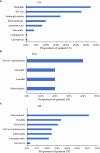Point prevalence survey to assess antibiotic prescribing pattern among hospitalized patients in a county referral hospital in Kenya
- PMID: 39816410
- PMCID: PMC11731622
- DOI: 10.3389/frabi.2022.993271
Point prevalence survey to assess antibiotic prescribing pattern among hospitalized patients in a county referral hospital in Kenya
Abstract
Antibiotic resistance causes higher morbidity and mortality and higher healthcare costs. One of the factors influencing the emergence of antibiotic resistance is the inappropriate use of antibiotics. Clinical practitioners' incorrect prescription patterns and a disregard for antibiotic usage recommendations are the leading causes of this resistance. This study examined the antibiotic prescription patterns among hospitalized patients at the Kiambu Level 5 hospital (KL5) to find potential for hospital quality improvement. This study was conducted in July 2021, and all patients hospitalized on the study day were included. The information was extracted from patient medical records using a World Health Organization Point Prevalence Survey (PPS) instrument. Anonymized data was gathered, entered, and then SPSS version 26 was used for analysis. Among the 308 surveyed patients, 191 (62%) received antibiotic medication, and 60.1% of the total were female. The pediatric ward, which had an antibiotic prescription rate of 94.1%, had the highest rate of antibiotic usage, followed by the medical ward (69.2%) and gynecological ward (65.6%). Over 40% of antibiotic prescriptions had a prophylactic medical indication. Penicillin G was the most prescribed antibiotic for community-acquired infections (32.2%), followed by 3rd generation cephalosporins (27.6%) and aminoglycosides (17.2%). Based on the AWaRe classification, 57% of the prescribed antibiotics were in the Access class while 42% were in the Watch class. Incomplete site of indication, lack of a method of administration, and length of administration are some of the conformities that were missing in the medical records. This study shows that antibiotic prescription rates are high, particularly for young patients, and there is a higher risk of antibiotic misuse. The data makes a compelling justification for using antibiotic stewardship practices in Kenyan hospitals.
Keywords: Kenya; antibiotic stewardship (ABS); antibiotic use; point prevalence; referral hospital.
Copyright © 2022 Kamita, Maina, Kimani, Mwangi, Mureithi, Nduta and Gitaka.
Conflict of interest statement
The authors declare that the research was conducted in the absence of any commercial or financial relationships that could be construed as a potential conflict of interest.
Figures




Similar articles
-
Antibiotic Prescriptions and Prophylaxis in Italian Children. Is It Time to Change? Data from the ARPEC Project.PLoS One. 2016 May 16;11(5):e0154662. doi: 10.1371/journal.pone.0154662. eCollection 2016. PLoS One. 2016. PMID: 27182926 Free PMC article.
-
A multicentre point prevalence survey of patterns and quality of antibiotic prescribing in Indonesian hospitals.JAC Antimicrob Resist. 2021 Apr 26;3(2):dlab047. doi: 10.1093/jacamr/dlab047. eCollection 2021 Jun. JAC Antimicrob Resist. 2021. PMID: 33937773 Free PMC article.
-
Point Prevalence Surveys of Antimicrobial Prescribing in a Non-Acute Care Hospital in Saitama Prefecture, Japan.Can J Infect Dis Med Microbiol. 2022 Mar 25;2022:2497869. doi: 10.1155/2022/2497869. eCollection 2022. Can J Infect Dis Med Microbiol. 2022. PMID: 35368518 Free PMC article.
-
Antibiotic Use Among Hospitalized Patients in Africa: A Systematic Review of Point Prevalence Studies.J Racial Ethn Health Disparities. 2024 Jun;11(3):1308-1329. doi: 10.1007/s40615-023-01610-9. Epub 2023 May 8. J Racial Ethn Health Disparities. 2024. PMID: 37157014 Free PMC article.
-
Antibiotic Use and Misuse in Dentistry in India-A Systematic Review.Antibiotics (Basel). 2021 Nov 26;10(12):1459. doi: 10.3390/antibiotics10121459. Antibiotics (Basel). 2021. PMID: 34943671 Free PMC article. Review.
References
-
- Amdany H. K., Mcmillan M. (2014). Metronidazole intravenous formulation use in in-patients in kapkatet district hospital, Kenya: a best practice implementation project. JBI Database Syst. Rev. Implement Rep. 12 (3), 419–432. doi: 10.11124/jbisrir-2014-1381 - DOI
-
- Anand Paramadhas B. D., Tiroyakgosi C., Mpinda-Joseph P., Morokotso M., Matome M., Sinkala F., et al. . (2019). Point prevalence study of antimicrobial use among hospitals across botswana; findings and implications. Expert Rev. Anti Infect. Ther. 17 (7), 535–546. doi: 10.1080/14787210.2019.1629288 - DOI - PubMed
LinkOut - more resources
Full Text Sources

